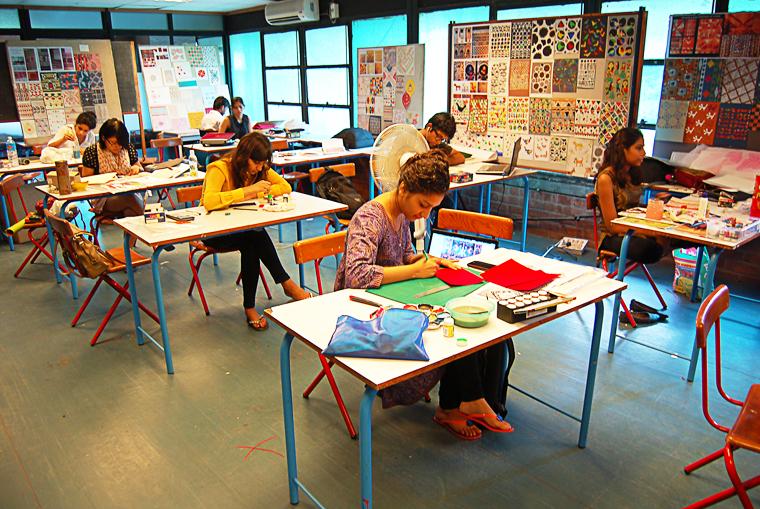If you have a passion for textile designing, this article will provide you with valuable insights into the scope of this field in Pakistan.Textile Designing is the fusion of artistic ingenuity and technical prowess, dedicated to crafting distinctive patterns, colors, and textures for fabrics. This multidimensional field caters to diverse applications, including fashion, interior decor, and industrial uses.
Textile designers master the art of harmonizing materials and techniques, skillfully conceiving designs ready for printing, weaving, or embroidery onto fabric. Their indispensable role lies in shaping the visual appeal and functionality of textiles, lending unique character to clothing, home furnishings, and various products. In essence, textile designers are the bridge between creativity and industry, infusing fabrics with a one-of-a-kind blend of style and utility.
[lwptoc]
Textile Designer
Textile designers create their blueprints for pattern designs or patterns on paper using computer applications like Evolution Textile Design applications, Artlandia SymmetryWorks, a plug-in for Adobe Illustrator, Bontex, or LECTRA. There are several different repeating patterns. Straight and half-drop are the most widely used. Sometimes, various colours of the same design are created.
Colorways are the term for them. The next step is to choose the fabric(s) on which to weave or print the pattern when the design or pattern is finished. Textile designers are exceptionally talented artists who sketch, have a remarkable eye for pattern, colour, and texture, and understand the finer points of clothing and textiles. They are knowledgeable about textile methods and can identify trends and fashion reversals. They are great communicators, possess problem-solving skills, and can relish the challenge of staying within budget and deadlines.
These patterns, which are frequently used in home furnishings and apparel, are produced by textile designers. The reader can better grasp the subjects of engineering and textile design thanks to the wide and comprehensive information provided here. This is an excellent chance to work in this industry. Are you aware that there is a daily increase in the need for textile engineers? It’s true! The fashion business is growing swiftly, and more textile designers and engineers are being hired by the sector.
Scope of Textile Designing in Pakistan
Textile Designing Career in Pakistan Courses, Scope and Jobs
Top 15 Career Opportunities in Fashion Designing Field
- Consultant
- Product promoters
- Stylist
- Costume designer
- Illustrator.
- Fashion designer
- Merchandiser
- Costume stylist
- Personal stylist
- Blogger
- Retail buyer
- Visual merchandiser
- Personal shopper
- Fashion publicist (PR)
- Fashion curator
Benefits of fashion designing in Pakistan
A profession in fashion design has several advantages. Through their job, fashion designers may exhibit their creativity. They are also capable of using a wide range of tools and methods. Fashion designers have a lot of independence and flexibility because they may work for themselves.
options for a career in fashion design:
For fashion designers, there are several employment options.
Fashion designers may operate as independent contractors.
internal designers for clothing companies
at fashion schools as lecturers or professors.
They can also take up positions in the fashion sector in marketing, public relations, or retail.
There are several things you can do to get ready if fashion design is something you’re interested in. You may establish your own fashion blog, enrol in fashion design school, or intern with a fashion designer. Additionally, you may establish contacts with industry experts and other fashion designers.
Fashion Designing Subjects in Pakistan
- Draping
- Bridal
- Apparel Design
- Sewing Design
- Fashion History
- Licensing
- Children’s Wear
- Intimate Apparel
- Fitting Design
- Haute Couture
- Flat Pattern Making
- Knitwear Design
Major Fields in Fashion Designing Degree
The three main areas of fashion design are as follows.
Garments Design
The art of making clothes for people of all ages and genders is this. It includes the design of clothing as well as the choice of materials, hues, and patterns. The designers must be creative, have a good sense of design, and be skilled in using a variety of tools and methods.
Leather Design
Designing leather goods include utilising leather to create items like purses, wallets, belts, and shoes. It includes the technique of manufacture as well as the choice of leather species, hues, and patterns. Designers of leather goods should be imaginative, have a keen eye for design, and be knowledgeable with a range of leathers and working methods.
Jewelry and Accessories Designs:
Design for jewellery and accessories includes making things like watches, necklaces, bracelets, rings, and earrings. It covers the artistry required in creating jewellery and accessories as well as choosing materials, colours, and designs. Designers in this sector need to have a strong sense of design, aesthetic talent, and the ability to deal with a variety of materials and methods.
Textile Designing Course Requirements
They need to fulfil the prerequisite requirements in order to enrol in a recognised college where they can study textile design. It is vital to have some knowledge or past experience at a beginning level due to the challenging nature of the course.
Undergraduate Courses
- It is necessary to pass a certified intermediate test or an exam of equal calibre given by a reputable board or institution.
Although there are several standards for establishing minimum grades, most universities demand an average between 50 and 60%.
Postgraduate Courses
- Candidates who have graduated from the design field (BDes) are eligible to apply for advanced courses in Textile Design. However, applicants from another stream who can demonstrate the abilities and skills are qualified to apply.
Textile Designing Salary in Pakistan
Pakistan offers a significant market for textile design. Beginners might expect a beginning wage of between Rs. 35,000 and 50,000 per month, depending on factors including their educational background, previous employment history, the demands of their profession, and the reputation of their company. Those with experience in the sector can make well over Rs. 100,000 per month, and some much more.
Textile Designing Universities in Pakistan
- National College Of Arts
- Pakistan Institute Of Fashion Design
- University Of Punjab
- University Of Sargodha
- Women University Swabi
- Iqra University
- Mehran University Of Engineering & Technology
- University Of Sindh
- Kinnaird College For Women
- Lahore College For Women University
- The Islamia University Of Bahawalpur
- Government College University, Faisalabad
- National Textile University
- University Of Gujrat
- Dadabhoy Institute Of Higher Education
- Indus University
- Shaheed Benazir Bhutto City University
Conclusion
In conclusion, this article has given you comprehensive information about the scope of textile designing in Pakistan. From an abundance of career opportunities to attractive salary prospects, this sector offers a promising future for talented designers. Consider pursuing a degree in textile designing and choose from among the leading universities in Pakistan to begin your journey towards a successful career in this thriving industry.
FAQs
- Is there any scope for textile designing in Pakistan?
Yes, there is significant scope for textile designing in Pakistan due to the growing textile industry and the demand for unique and innovative designs. Pakistani textile designers have opportunities to work with famous fashion brands, textile manufacturers and exporters, and the growing trend of conscious consumerism further widens the scope for designers in the country.
- What is the scope of textile design?
The scope of textile design is broad and diverse, covering industries such as fashion, home furnishings, interior design, automotive, and technical textiles. Textile designers contribute to the aesthetic appeal and functionality of fabrics and products through their expertise in pattern, print and texture design. They can work as freelancers, in-house designers, or start their own design studios. The field also extends to research, sustainability and innovation in textile materials and techniques.
- What is the scope of textiles and clothing in Pakistan?
The textile and clothing industry in Pakistan provides significant employment opportunities and contributes to the country’s economy through exports.
- Is textile design a good degree?
Yes, textile design is a good degree for those interested in the creative field and fashion industry.

